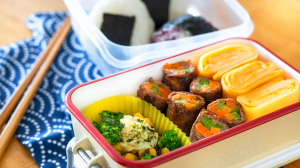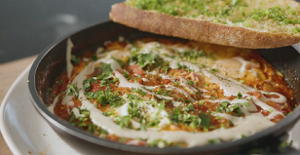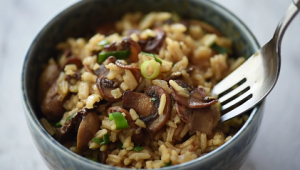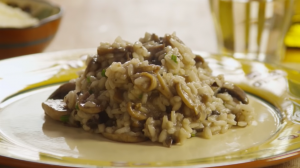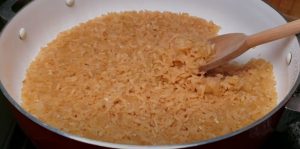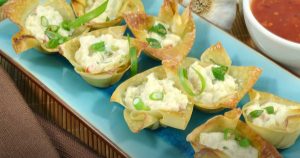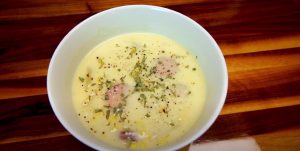Enjoy a delightful bite of Japanese cuisine with shrimp onigiri. Crispy fried shrimp nestled in seasoned rice, wrapped in seaweed, offers a perfect blend of textures and flavors.
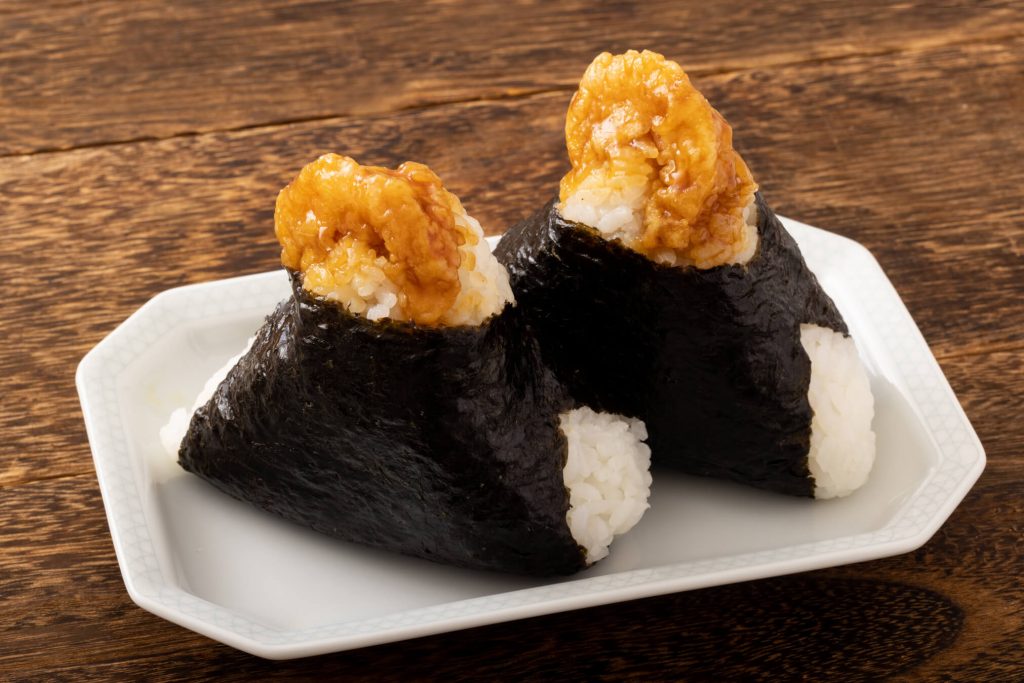
Photos of Japanese Shrimp Onigiri Recipe
If you are not familiar with Japanese cooking, some ingredients might be new to you. Dashi is a Japanese soup stock, mirin is a sweet rice wine, and seaweed is typically sold in sheets. These can often be found in the international aisle of a well-stocked supermarket.
Ingredients For Japanese Shrimp Onigiri
Egg: Used to create a batter for frying the shrimp.
All-purpose flour: Provides the base for the batter and for dredging the shrimp.
Cold water: Ensures the batter remains light and crispy.
Raw shrimps: The main protein, offering a succulent bite within the onigiri.
Oil: Essential for frying the shrimp to a golden brown.
Dashi: A savory Japanese soup stock that adds umami to the dish.
Soy sauce: Adds a salty and rich flavor to the shrimp.
Mirin: A sweet rice wine that balances the soy sauce.
Rice: The base of the onigiri, providing a fluffy and sticky texture.
Salt: Used to season the rice and enhance its flavor.
Seaweed strip: Wraps around the rice ball, adding flavor and a slight crunch.
One reader, Alic Foy says:





This Japanese shrimp onigiri recipe is a delightful treat! The crispy shrimp paired with the flavorful rice and seaweed creates a perfect bite. Easy to follow and absolutely delicious, it's a must-try for any sushi lover.
Techniques Required for Making Japanese Shrimp Onigiri
How to dredge shrimp: Coat each shrimp in flour, ensuring an even layer, and shake off any excess flour. How to heat oil to 350 degrees F: Use a deep-fry thermometer to monitor the oil temperature, ensuring it reaches 350 degrees F before frying. How to fry shrimp: Dip the floured shrimp into the batter and fry in hot oil until they float and turn golden brown. How to make dashi: Combine water with dashi powder or use homemade dashi stock. How to make onigiri: Wet your palms, coat with salt, shape the rice into a ball with an indent, place the shrimp in the center, and form a triangle shape. How to wrap seaweed: Place a strip of seaweed around the rice ball to secure it.
How To Make Japanese Shrimp Onigiri
Onigiri is a popular Japanese snack made of seaweed-wrapped rice balls. Make this deep-fried tempura onigiri recipe as a great to-go snack.
Serves:
Ingredients
- 1egg
- 1cupall-purpose flour,divided
- ½cupcold water
- 8raw shrimps,peeled and deveined, tails left on
- oil,for frying
- ¾cupdashi
- ¼cupsoy sauce
- ¼cupmirin
- 2½cupsrice,cooked, for serving
- salt,to taste
- 1seaweed strip,roasted, cut into 8 equal pieces
Instructions
-
Whisk the egg in a small bowl. Add 1/2 cup of flour and the cold water and whisk to combine.
-
Cover with plastic wrap and chill in the refrigerator.
-
Add the remaining flour to a shallow dish. Dredge each shrimp in the flour, shaking off any excess.
-
Heat the oil in a large pot until it reaches 350 degrees F.
-
Dip the floured shrimp into the chilled batter.
-
Fry the shrimp until they float to the top and are golden brown in color.
-
Use a slotted spoon to transfer the shrimp to a paper towel-lined plate to drain.
-
In a medium pan, combine the dashi, soy sauce, and mirin, and bring to a boil over high heat. Transfer to a small bowl.
-
To make the onigiri rice balls, first wet your palms with water and coat with a little bit of salt.
-
Take a handful of rice and make an indent in the middle.
-
Dip a shrimp into the soy sauce mixture, then place in the center of the rice.
-
Wrap the rice around the shrimp, creating a triangle shape.
-
Wrap a strip of seaweed around the rice ball. Repeat with remaining ingredients.
Nutrition
- Calories: 322.63kcal
- Fat: 3.21g
- Saturated Fat: 0.49g
- Trans Fat: 0.01g
- Monounsaturated Fat: 1.60g
- Polyunsaturated Fat: 0.87g
- Carbohydrates: 61.14g
- Fiber: 0.49g
- Sugar: 0.10g
- Protein: 8.33g
- Cholesterol: 27.77mg
- Sodium: 515.21mg
- Calcium: 18.40mg
- Potassium: 152.42mg
- Iron: 1.45mg
- Vitamin A: 13.12µg
- Vitamin C: 0.15mg
Technique Tip for Perfect Japanese Shrimp Onigiri
When making onigiri, ensure your hands are slightly damp and salted to prevent the rice from sticking to your palms and to add a subtle layer of seasoning to the rice balls.
Time-Saving Tips for Preparing This Japanese Recipe
Prepare ingredients ahead: Measure and prepare all ingredients in advance to streamline the cooking process.
Use a rice cooker: Cook rice in a rice cooker to save time and ensure perfect texture.
Pre-make dashi: Prepare dashi stock in bulk and store it in the fridge for quick access.
Chill batter quickly: Place the batter in the freezer for a few minutes instead of the fridge to speed up chilling.
Batch fry shrimp: Fry multiple shrimps at once to reduce cooking time.
Assemble efficiently: Set up an assembly line with rice, shrimp, and seaweed to make onigiri quickly.
Substitute Ingredients For Japanese Shrimp Onigiri Recipe
egg - Substitute with flaxseed meal: Mix 1 tablespoon of flaxseed meal with 3 tablespoons of water to replace one egg. This works well as a binding agent.
all-purpose flour - Substitute with rice flour: Rice flour is a common ingredient in Japanese cuisine and provides a similar texture.
cold water - Substitute with sparkling water: Sparkling water can make the batter lighter and crispier.
raw shrimps - Substitute with cooked chicken: For those who do not eat seafood, cooked chicken can be a good alternative.
oil - Substitute with sesame oil: Sesame oil adds a nutty flavor that complements Japanese dishes well.
dashi - Substitute with vegetable broth: Vegetable broth can be used as a base if dashi is not available, though it will lack the umami flavor.
soy sauce - Substitute with tamari: Tamari is a gluten-free alternative to soy sauce and has a similar taste.
mirin - Substitute with dry sherry: Dry sherry can mimic the sweetness and acidity of mirin.
rice - Substitute with quinoa: Quinoa can be used as a healthier alternative to rice, though it will change the texture.
salt - Substitute with soy sauce: Soy sauce can add both saltiness and umami flavor.
seaweed strip - Substitute with lettuce leaf: A lettuce leaf can be used to wrap the onigiri if seaweed is not available.
Best Way to Present Shrimp Onigiri
Serve smaller portion sizes: Present the onigiri in bite-sized portions to highlight the delicate flavors and craftsmanship. This allows each guest to savor the intricate details of the dish.
Use decoration: Garnish the plate with finely sliced radish and cucumber flowers to add a touch of elegance and color contrast. A small sprig of shiso leaf can also enhance the visual appeal.
Highlight the shrimp: Position the golden-brown shrimp prominently on top of the onigiri, allowing its crispy texture to be the star of the dish. This creates a striking visual and textural contrast.
Sauce presentation: Serve the soy sauce mixture in a small, elegant dipping bowl on the side. This allows guests to control the amount of sauce they use, enhancing the dining experience.
Use premium ingredients: Ensure that the dashi, soy sauce, and mirin used are of the highest quality to elevate the overall flavor profile of the dish.
Plate arrangement: Arrange the onigiri on a minimalist, dark-colored plate to make the white rice and golden shrimp pop visually. This creates a sophisticated and modern presentation.
Texture contrast: Add a small side of pickled ginger or daikon to provide a refreshing crunch and a palate cleanser between bites.
Temperature control: Serve the onigiri slightly warm to enhance the comfort and satisfaction of the dish, while ensuring the shrimp remains crispy.
Attention to detail: Use a fine brush to lightly coat the seaweed strip with a touch of soy sauce for added flavor and a glossy finish, enhancing the visual appeal.
Balance of flavors: Ensure that each onigiri has the right amount of salt and soy sauce mixture to achieve a harmonious balance of flavors, making each bite a delightful experience.
Essential Tools for Making Japanese Shrimp Onigiri
Small bowl: Used for whisking the egg and combining it with flour and cold water to make the batter.
Plastic wrap: Used to cover the batter and chill it in the refrigerator.
Shallow dish: Used for dredging the shrimp in flour before dipping them into the batter.
Large pot: Used for heating the oil to fry the shrimp.
Thermometer: Used to ensure the oil reaches the correct temperature of 350 degrees Fahrenheit.
Slotted spoon: Used to transfer the fried shrimp to a paper towel-lined plate to drain excess oil.
Paper towel-lined plate: Used to drain the fried shrimp after cooking.
Medium pan: Used for combining and boiling the dashi, soy sauce, and mirin.
Small bowl: Used to hold the soy sauce mixture after it has been boiled.
Rice cooker: Used to cook the rice to the perfect consistency for making onigiri.
Water bowl: Used to wet your palms before shaping the rice balls.
Seaweed strip: Used to wrap around the rice balls to hold them together.
Measuring cups: Used to measure out the ingredients accurately.
Whisk: Used to combine the egg, flour, and cold water into a smooth batter.
Storing and Freezing Japanese Shrimp Onigiri
- To store leftover japanese shrimp onigiri, wrap each rice ball tightly in plastic wrap or place them in an airtight container. They can be kept in the refrigerator for up to 2 days.
- For best results, consume the onigiri within 24 hours of making them, as the rice may become harder and lose its texture over time.
- If you want to freeze the onigiri, wrap each one individually in plastic wrap, then place them in a freezer-safe container or bag. Label the container with the date and contents.
- Frozen onigiri can be stored for up to 1 month. When ready to eat, remove the desired number of onigiri from the freezer and let them thaw in the refrigerator overnight.
- To reheat the thawed onigiri, unwrap the plastic and microwave for 30-45 seconds, or until heated through. You can also reheat them in a steamer for a few minutes to restore the soft texture of the rice.
- If you prefer a crispy exterior, you can pan-fry the thawed onigiri in a little bit of oil over medium heat until the surface is golden brown and crispy.
- Note that the seaweed wrapper may lose its crispness after freezing and thawing, so you can replace it with a fresh strip of nori before serving, if desired.
How to Reheat Leftover Shrimp Onigiri
To reheat leftover japanese shrimp onigiri, the best method is to use a steamer basket. Place the onigiri in the steamer basket and cover with a lid. Steam for 5-7 minutes, or until heated through. This method will help to retain the moisture and texture of the rice and prevent the shrimp from becoming rubbery.
Another option is to reheat the onigiri in the microwave. Wrap each onigiri individually in damp paper towels and microwave on high for 30-45 seconds, or until heated through. Be careful not to overheat, as this can cause the rice to become tough and the shrimp to overcook.
If you prefer a crispy exterior, you can reheat the onigiri in a toaster oven or conventional oven. Preheat the oven to 350°F (175°C) and place the onigiri on a baking sheet lined with parchment paper. Bake for 8-10 minutes, or until heated through and slightly crispy on the outside.
For a quick and easy method, you can also reheat the onigiri in a skillet. Heat a small amount of oil in a skillet over medium heat. Add the onigiri and cook for 2-3 minutes on each side, or until heated through and slightly crispy.
Regardless of the reheating method you choose, be sure to consume the reheated onigiri promptly to ensure the best quality and safety. If you have any leftover soy sauce mixture, you can brush it over the reheated onigiri for added flavor.
Random Fact About Japanese Shrimp Onigiri
A unique aspect of this Japanese shrimp onigiri recipe is the use of dashi, a traditional Japanese soup stock made from dried fish and seaweed. This ingredient adds a rich umami flavor to the soy sauce mixture, enhancing the overall taste of the onigiri.
Is Making Shrimp Onigiri at Home Economical?
This Japanese shrimp onigiri recipe is moderately cost-effective. The main expenses are shrimp, dashi, and seaweed. The other ingredients like rice, soy sauce, and mirin are relatively inexpensive and can be used in multiple dishes. For a household of 4, the approximate cost is around $20-$25. Overall Verdict: 7/10.
Is This Japanese Dish Healthy or Unhealthy?
The Japanese shrimp onigiri recipe, while delicious, may not be the healthiest option due to a few factors:
- The shrimp is deep-fried, which adds extra fat and calories to the dish
- The batter for the shrimp contains all-purpose flour, which is refined and lacks fiber and nutrients
- The soy sauce mixture used for dipping the shrimp contains a significant amount of sodium
However, the recipe does include some healthy elements, such as:
- Shrimp is a lean protein source and provides essential nutrients like omega-3 fatty acids
- The use of seaweed adds iodine and other beneficial minerals to the dish
- Rice, when consumed in moderation, can be a part of a balanced diet
To make this recipe healthier, consider the following suggestions:
- Instead of deep-frying the shrimp, try grilling, baking, or pan-searing them with minimal oil to reduce the fat content
- Replace all-purpose flour with whole wheat flour or a gluten-free alternative like rice flour to increase the fiber and nutrient content
- Reduce the amount of soy sauce used in the dipping mixture and consider using low-sodium soy sauce to decrease the overall sodium content
- Add more vegetables to the onigiri, such as finely chopped carrots, cucumbers, or avocado, to increase the fiber and nutrient density of the dish
- Use brown rice instead of white rice to increase the fiber content and provide more nutrients like magnesium and selenium
Editor's Thoughts on Japanese Shrimp Onigiri
This recipe offers a delightful fusion of textures and flavors, combining crispy fried shrimp with the savory essence of dashi, soy sauce, and mirin. The process of making onigiri adds a traditional Japanese touch, enhancing the overall authenticity. However, the inclusion of an egg batter for the shrimp is unconventional for onigiri, which typically uses plain or lightly seasoned fillings. Adjusting the batter to a lighter tempura style could improve the balance. Overall, it's an innovative twist on a classic dish that promises a satisfying culinary experience.
Enhance Your Japanese Shrimp Onigiri Recipe with These Unique Side Dishes:
Alternative Recipes Similar to Japanese Shrimp Onigiri
Appetizers and Desserts to Complement Japanese Shrimp Onigiri
Why trust this Japanese Shrimp Onigiri Recipe:
This recipe combines authentic Japanese flavors with a modern twist, ensuring a delightful culinary experience. The use of dashi, soy sauce, and mirin adds depth and umami to the dish, while the crispy fried shrimp provides a satisfying texture. The detailed instructions make it easy to follow, even for beginners. Trust this recipe to bring a taste of Japan to your kitchen.
Was this page helpful?
Have your own special recipe to share? Submit Your Recipe Today!
